Last updated: 08 September 2018, 09:30
255 Squadron in England
1940 to 1942
Quick Links:
The squadron at Kirton Lindsey
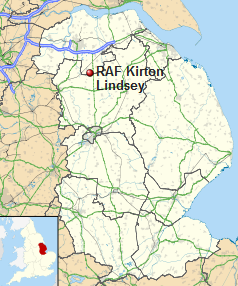
Location map for RAF Kirton Lindsey. Map shows modern road layout and Local Government boundaries.
[Map template : Wikipedia] |
|
The squadron re-formed on 23 November 1940. Unlike the WWI situation, this date is precisely recorded in an Operations Record Book (ORB),
[1] but there is some uncertainty about the correct description of the location. Kirton Lindsey or Kirton-in-Lindsey?
It appears to have been an RAF habit (inherited from the RFC) to name its bases after the nearest railway station, possibly to simplify the process of issuing Rail Warrants to personnel posted there. By that token, 255 was re-born at RAF Kirton Lindsey, that being the name of the nearby railway station constructed in 1849. The squadron’s Operations Record Book [2] consistently uses that version of the name. So does the airfield’s separate ORB, from the date of the site’s first WWII occupation (15 May 1940) through to May 1941. After mid-1941, use of “RAF Kirton-in-Lindsey” begins to appear – eventually dominating. [3] Given that all No.255 Squadron records refer to "Kirton Lindsey", that name is used here. By the time the "-in-" version was adopted on the airfield, No.255 Squadron had moved on to their next home.
The squadron became operational as a night fighter unit, as part of No.12 Group, on 5 Jan 1941, but due to snow no flying took place until 8 Jan 1941. [4] They were flying Bolton Paul Defiant Mk.I aircraft without on-board radar. |
Ground-Controlled Interception, called "GCI", was used to guide a single fighter aircraft towards its target, using a procedure called "vectoring". In effect, the GCI Station did the work of a navigator, calculating the course to steer and altitude to achieve in order to intercept the moving target. The ground station then transmitted this information to the fighter pilot by radio. Only if the guidance was accurate enough to bring the fighter within visual range of the target did an interception result. Perhaps surprisingly often, despite the darkness, it did!
The Boulton Paul Defiant Mk.I turret fighter
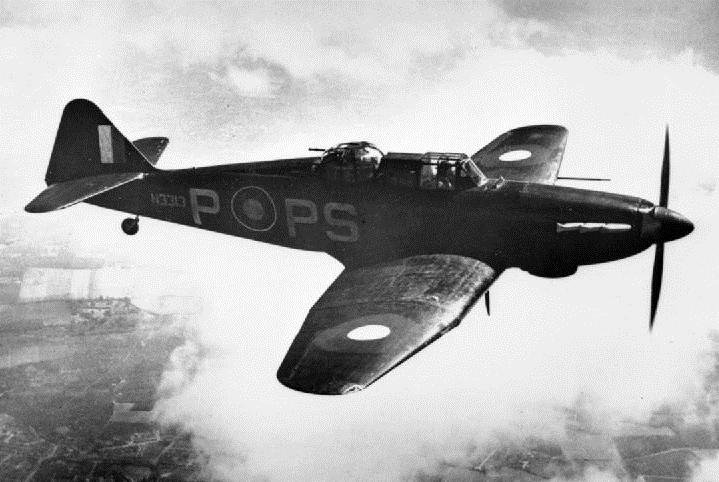 |
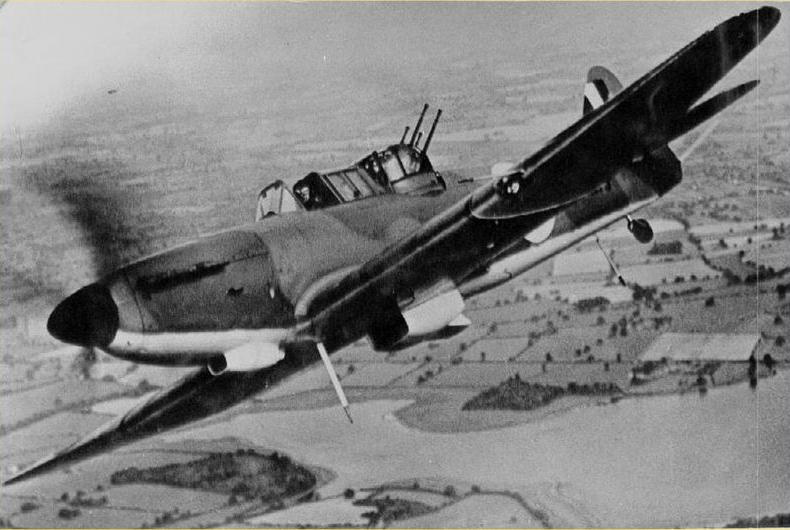 |
Left: Defiant Mk.I, night camouflage, markings of No.264 Squadron. Public Domain image.
Right: Defiant Mk.I, day camouflage, unknown squadron. Public Domain image.
External link to YouTube video about the Defiant - click on the icon!  |
An entry in the Form 541 appendix to the ORB, dated 8 January 1941 sees the squadron’s only documented use of "Pip-squeak", fitted to Defiant Mk.I serial N3378. Pip-squeak was a direction-finding system that auto-keyed a spare channel on the transmitter of the aircraft’s HF radio telephone, enabling a network of HF/DF (High Frequency Direction Finding) ground stations to obtain a rapid "fix" on the aircraft whether or not the voice communication facility was in use. A change to VHF radios, already under way and accompanied by the contemporaneous installation of IFF (Identification Friend or Foe), rendered the whole Pip-squeak system redundant.
[5] [6]
On 2 February 1941 the squadron suffered its first fatality when Defiant Mk.I serial N3306 stalled on final approach. The pilot, 748209 Sergeant Alan R. Jacobs was killed instantly. His Air Gunner, 935568 Sgt. P.V. Thornton, escaped with minor head injuries.
[7] The ORB attributes the crash to Pilot Error.
The night of 10-11 February 1941 saw the first combat successes
[8]. On the same night a Defiant of No.255 Squadron was damaged when a Spitfire of another squadron taxied into it. Two further on-the-ground incidents followed on the 16th.
17 February saw the completion of the fitting of VHF radios to the squadron’s aircraft, a process that had taken nearly two months.
At 02:48 on 14 March 1941, Sgt. A.R. Smith (Pilot) and Sgt. H.A. McKenzie (Air Gunner) had the un-nerving experience of having an enemy aircraft – presumed to be a Junkers Ju.88 – rake them with machine-gun fire as they landed, the Hun having followed them in. They and their Defiant escaped unscathed but a parked Spitfire of No.65 Squadron suffered minor damage.
[9]
During their time at Kirton Lindsey, the Defiants were supplemented with five Hawker Hurricane single-seat fighters, which achieved two combat victories. These arrived over the period 21-23 March, but not all were in serviceable condition on receipt.
On the night of 16-17 April 1941 the airfield was bombed; there was no significant damage.
The ORB entry for 1 May 1941, written up at the end of the month, makes reference to the activities throughout May 1941 in the following terms:
"This moonlit period (till 17/5/41) was one of intense enemy 'blitzing' of target areas in N.E. and Central England and in consequence a considerable strain was thrown on the Squadron. Each night one flight was at 'readiness' with the other 'available', and on some occasions during the peak moonlit period as many as sixteen planes have been at 'readiness'. From the assumption of dusk state on 2/5/41 till the end of dusk state on 17/5/41 (15 nights) a total of one hundred and thirty-two operational night patrols were flown. In fact a total of eighty-eight were flown in the 6 nights from midnight on 10/5/41, an average of more than 14½ patrols per night. The squadron had its most successful period since its formation, as will be seen from the victories set out infra. The most satisfactory aspect of these combats is that the losses inflicted on the enemy were all achieved at the loss of only one Defiant both the occupants of which landed safely by baling out of their burning machine."
The highlight came in the early hours of the ninth of May, when the squadron shot down 6 enemy bombers and damaged a seventh within the space of half an hour, all achieved without loss to the squadron’s personnel or planes. This produced a deluge of congratulations, headed by a personal message from the Rt. Hon. Sir Archibald Sinclair, Bt., CMG, MP, the Secretary of State for Air.
[10]
It was a magnificant finale to the squadron’s time at RAF Kirton Lindsey, which the aircraft and aircrews left on the 15th. Due to some facilities at RAF Hibaldstow not being complete, the squadron’s administrative HQ and some maintenance activities remained at Kirton Lindsey. The split of administrative location continued until 9 June.
[11]
The squadron at Hibaldstow
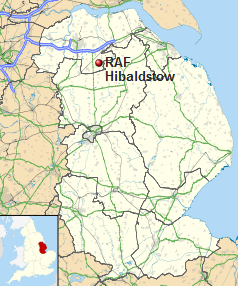
Location map for RAF Hibaldstow. Map shows modern road layout and Local Government boundaries.
[Map template : Wikipedia] |
|
What might have proved to be a busy and productive period in the squadron’s history turned out not to be. Much of the Luftwaffe bomber force that had been ranged against the East Coast ports of Hull and Grimsby during the squadron’s time at RAF Kirton Lindsey had, in May 1941, been moved to the Russian Front ready to support Operation Barbarossa, the German invasion of Eastern Europe. In local terms at least, the Blitz was over. Apart from some token raids probably designed to create the pretence of ongoing strategic bombing, the night fighters guarding the ports of the Humber Estuary were left short of targets.
On 16 June 1941 the squadron took delivery of its first Bristol Blenheim Mk.I light bomber, for the purposes of training on twin engined aircraft prior to being re-equipped with Bristol Beaufighters. [12] A second Blenheim (L1223) [13] was collected from No.18 Maintenance Unit on 06 July and a third (recorded in the ORB as L8660 but thought actually to be L8680) was delivered on 19 July. [14]
During the night of 05/06 July, there was a collision on the runway between Defiants N1581 and N1740. Sgt. J.B.Bayliss slightly injured, giving rise to Casrep report AIR81/7401 (declassified August 2018). The TNA catalogue entry suggests that the Casrep file includes photographs, but none were found when the file was checked 06.Sep.2018.
On night 10–11 July at about 02:00, Air Gunner Sgt. H.D.J. Fitzsimons, a New Zealander (NZ39097), was hit by a tracer bullet fired from an enemy aircraft believed to be a Heinkel He.111. Fitzsimons nevertheless continued to fire at the enemy bomber, which was claimed as "damaged". [15] Pilot Sgt.Cox returned to base and his Air Gunner was taken to Scunthorpe War Memorial Hospital. [16] The RAF aircraft involved was Defiant T3995. |
Official notification was received on 13 July of the upcoming re-equipment with Beaufighters. The first two of these much heavier fighter aircraft (R2370 and R2377), nominally similar in handling characteristics to the Blenheims used for training, arrived on 22 July. More followed on the 24th and the 27th, a ninth arriving the following day and a tenth by the end of the month. The total reached the full compliment of 18 on 6 August.
[17]
The Bristol Beaufighter Mk.II night fighter (Merlin XX engines)
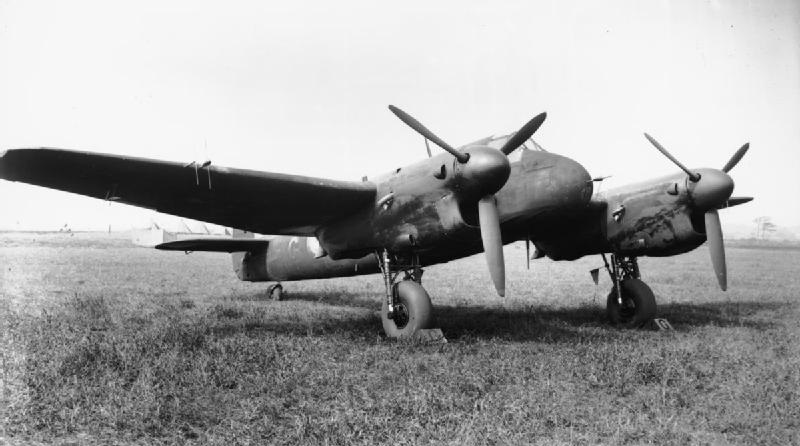 |
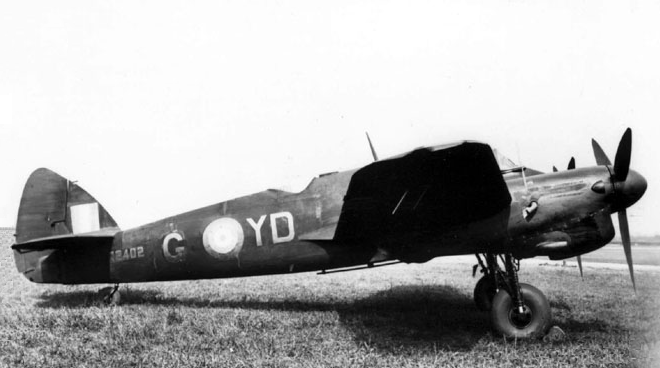 |
Left: 255 Squadron RAF Beaufighter Mk.II YD-G (R2402) photographed at RAF Hibaldstow 5 September 1941. Note the flat tailplane (no dihedral) and the Mk.IV AI radar aerials. The transmit aerial is on the nose of the fuselage and the receive aerials are on the leading edge of each wing. This image was at one time mis-catalogued by IWM as having been taken at RAF Coltishall. R2402 did subsequently move to Coltishall later in September 1941, but it was at Hibaldstow when photographed on the fifth. Public Domain image.
Right: The same aircraft, side view. Both images can be enlarged using your browser’s magnifier (eg CTRL+). |
The Mk.II Beau was under-powered compared with the Mk.I. The Beaufighter airframe had been designed around the Bristol Hercules engine, the Mk.VI version of which, on take-off, delivered 1615 BHP (1204 kW). Rolls-Royce Merlins, however, only managed 1280 BHP (954 kW), a shortfall of approximately 21%.
[18] The decision to fit Merlin XX engines to Beaufighters came about because of an anticipated shortage of Hercules engines.
[19] As the Squadron’s experience over the next few months was to show, the airframe/engine combination was not a particularly successful one.
The squadron’s next move, from Hibaldstow to Coltishall, commenced on 16 August 1941. Tragically it resulted in the deaths of 81449 Flying Officer James Howard Emmerson (known as Jimmy) and 748529 Sergeant Donald Crosby Fowler when Blenheim L1223 crashed on approach to RAF Coltishall, hitting trees about ¾ mile from the airfield. This incident was eventually attributed to loose spark plugs in the port engine, occasioned by slack maintenance procedures.
[20] It marked the start of a grim period in the squadron’s history. The transition from single to twin-engined aircraft did not go smoothly and it would take over a year, diagnosis of the cause of multiple engine supercharger failures on the Beaufighter Mk.II’s Merlin XX engines, re-equipment with Mk.VI Beaufighters (which had Bristol Hercules engines) and a move to North Africa before combat victories resumed in numbers that exceeded the Squadron’s aircrew losses to causes other than enemy action.
The Squadron was deemed non-operational from 18:00 on 23 August 1941, so as to "complete conversion to and training on Beaufighters".
[21] All but two aircraft were ordered back to RAF Hibaldstow, the two remaining at Coltishall being attached to No.604 Squadron. 604 was a unit with greater experience of flying Beaufighters equipped with AI and the application of that aircraft/radar combination to the business of delivering an effective night fighter defence role. Evidently only two of 255’s crews were deemed to be combat ready in their new aircraft.
Some of the Squadron’s paperwork from September 1941 appears at first sight to be missing, specifically Forms 541 relating to the period from the 1st to the 25th of the month. However, enhanced detail entered on Form 540 may indicate that the 541s were never created in the first place.
The second attempt to move to Coltishall happened 19–21 September, leaving unsolved the mystery of 45843 Pilot Officer James Craig’s disappearance on a flight from Turnhouse (Edinburgh) to Hibaldstow on 29 August in Defiant Mk.I serial N3378.
The squadron at Coltishall, with a Detachment at West Malling
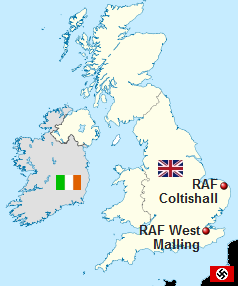
Location map showing the strategic front-line locations of RAF Coltishall and RAF West Malling.
[Map template : Wikipedia] |
|
On 23 September the squadron was informed that a crashed aircraft had been found near the Woodhead Tunnel, high in the Pennines, and that two bodies had been taken to Glossop Police Station mortuary. These casualties, found close to Near Bleaklow Stones, [22] subsequently proved to be the remains of Pilot Officer Craig and a passenger, 1103778 Aircraftman 1st Class George Daniel Hempstead, whose presence on board had not at first been known to the squadron. Craig’s aircraft had been reported missing/overdue on a flight from Turnhouse (Edinburgh) to Hibaldstow since 29 August. A subsequent report received 27 September 1941 from No.10 Balloon Centre stated that Pilot Officer Craig’s aircraft had many bullet holes in it, suggesting enemy action. [23] For some years the aircraft’s radiator cowling remained at the crash site, showing clear evidence of such damage. However, it was removed by persons unknown some time prior to 1979. [24]
Fatal accidents involving Beaufighter flights into or out of Coltishall itself cost the lives of two successive Commanding Officers, amongst others. On 22 August 1941 a crash on landing killed 34037 Wing Commander John Stuart Bartlett, DFC. An engine failure on 08 December 1941, sustained whilst "going round again" on account of difficulty with the plane’s hydraulics, killed his successor 26193 Wing Commander Charles Mervyn Windsor. Both these men were career officers (not RAFVR wartime recruits) and both were experienced pilots. |
The ORB entry for 26 December 1941 acknowledges that a series of adverse events suffered since conversion to Beaufighter Mk.II aircraft had seriously dented morale. In what was obviously an attempt to restore faith in the Beaufighters, 33041 Wing Commander Peter Stanley Salter, AFC, of the RAF Handling Squadron, then an offshoot of the Central Flying School, visited and demonstrated the Beaufighter Mk.II in flight. A further demonstration was given by the same officer three days later.
The general tone of the squadron’s records at this time, along with squadron pilot 89625 Pilot Officer Michael F. Wynne-Willson’s comments in his autobiography, suggest deep disillusionment with their equipment. Regarding the Beaufighter II crash that killed Johnny Bartlett and Tom Salkeld on 22 August 1941, Michael wrote...
"It was then that we all learned for the first time that these aircraft were un-flyable on one engine with wheels and flaps down."[25]
Michael’s description of the practical consequences of asymmetric power in a Beaufighter Mk.II seem fully justified when one takes into consideration some tests done at Royal Aircraft Establishment Farnborough in April 1945, during which one engine was deliberately shut down in flight:
"At speeds below 140 mph the aeroplane appeared to roll immediately the engine was cut... Recovery was effected by throttling back the live engine... Since recovery necessarily entails an appreciable loss of height, the manoeuvre would be very dangerous at low altitudes (e.g. after take-off)".[26]
The RAE experiments took place more than three years after No.255 Squadron’s problems with the Mk.II Beaufighter, but the October 1941 edition of Pilot’s Notes
[27] validate Michael’s comments about the type being un-flyable in certain low-airspeed conditions. As here, the original official publication is in Block Capitals:
NO ATTEMPT MUST EVER BE MADE TO FLY LEVEL ON
ONE ENGINE WHEN THE FLAPS ARE FULLY DOWN.
Interestingly the same document recommends that flaps should not be used at all for take-off. The aircraft evidently had a very strange set of handling characteristics, brought about by aerodynamic issues the consequences of which were made all the more prominent by frequent engine failures.
In his autobiography, Michael Wynne-Willson went on to consider the effect of a supercharger failure during take-off...
"[The loss of power on one side] ...caused the wing to drop and the plane to stall... and... dive into the ground. Nothing the pilot could do could possibly save him, his radar operator or his aircraft... The consequences of this happening were always terminal and, thank God, instantaneous."[28]
Other activities carried on against this unhappy background. Christmas Eve 1941 saw 42503 Flight Lieutenant Gilbert McLean Hayton (Senior pilot of "A" Flight; the Air Force List gives his rank as Flying Officer apparently in error) and 45844 Pilot Officer Norman Herbert Josling (Radio Operator) chosen as volunteer crew to fly a Beaufighter to the Middle East.
On New Year’s Day 1942, 89594 Pilot Officer John Douglas Wright collected Miles Magister BB665 from St.Athan. It is unclear whether this aircraft, nominally a basic trainer, was subsequently used other than as an air taxi, but it does appear in Wing Commander Kelly’s flying log book for January 1942 in that role.
[29]
Come the third of January, five Beaufighter aircraft were moved on detachment to RAF West Malling. 255 Squadron in effect became twinned with No.29 Squadron in order to provide crew rotation out of territory still documented in the ORB as "Hell Fire Corner". On 14 January 1942, 255 Squadron crews on this rotation did score one combat victory, a Dornier Do.217 shot down off Ostend,
[30] [31] but successes remained elusive. The rotation arrangement continued until 16 February 1942.
The 'atmosphere' at Coltishall presented the Squadron’s new CO, ex-Battle of Britain pilot 33168 Wing Commander Piers Kelly, with a major man-management challenge. Nor could things have been easy for 45393 Flight Lieutenant Percy Charles ("Wilbur") Wright, the squadron’s Engineering Officer. Why were so many aircraft suffering engine failure in non-combat incidents? Was the problem a design fault, pilot error, or another maintenance issue akin to the one that had resulted in the deaths of Jimmy Emmerson and Donald Fowler back in August 1941?
Supercharger gearbox failures, especially in the moments of maximum power demand at take-off, were suspected. On 9 January 1942 a conference took place at RAF Coltishall, four representatives of Rolls-Royce attending in order to address the specific matter of "MS and FS failures".
[32]
On 14 February 1942, 1283892 F/Sgt Ronald Lionel Vince (Pilot) and 933259 Sergeant Reginald Lewis Miller (Radio Operator) proceeded to RAF Honeybourne to ferry an aircraft to the Middle East – not the first crew to have volunteered for an overseas adventure. Vince's initials appear to have fallen victim to a typing error in AIR27/1518, where he appears as E.L.Vince. RAF Honeybourne was at the time the location of 1425 (Ferry Training) Flight, which specialised in Liberator bombers. However, the records of No.44 Group suggest that 1425 also undertook medical preparation of Beaufighter crews as well as training in matters such as what to do in the event of a forced landing in neutral or enemy territory.
Given that most Beaufighters being sent overseas were Mk.I machines, such volunteering was an understandable reaction to the general feeling prevalent at Coltishall that flying Mk.II Beaus was akin to playing Russian roulette. Not that it saved Vince and Miller; both were posted missing believed killed 22.April.1942 following the disappearance of a Wellington bomber HF849 conveying them and others as passengers from Malta to 102MU at Abu Sueir, Egypt. At the time of updating this paragraph (July 2016) it is unclear whether they had already made other delivery runs on behalf of OADU.
28 February 1942 saw the first indication that the squadron was to be re-equipped with either Beaufighter Mk.VI or Mosquito aircraft, a change also involving a move from RAF Coltishall to RAF High Ercall in No.9 Group’s area.
[33] That relocation commenced 2 March 1942, again taking the squadron out of the front line. Once the root causes of the high accident rate amongst experienced pilots had been identified, the Air Ministry listened and took action just as soon as the aircraft supply situation permitted. But the diagnosis and consequent decision to re-equip came too late to save the lives of a number of brave and experienced men and the whole débâcle cast a very long shadow over squadron morale.
The problem with the Merlin XX engines was eventually traced to the gears and clutch of the two-speed supercharger gearbox, some parts of which were manufactured under licence by Rolls-Royce to a pre-war design by the French company Farman. The minutes of a meeting of the Directorate of Engine Development (a division of the Ministry of Aircraft Production, a wartime offshoot of the Air Ministry) held on 18 March 1942 state that the meeting heard a report of "95 failures... in 12 months and No.255 Beaufighter squadron in particular had suffered".
Unfortunately, the squadron’s Form 765C archive has not survived, precluding a full analysis of the supercharger failures via that route. What can be said, on the basis of such records as do survive elsewhere,
[34] is that the Squadron suffered 20 non-combat incidents whilst at Coltishall. An "incident" in this context is taken as being an event resulting in death, injury, damage to an aircraft or a forced landing away from home base. Of the 20 such recorded incidents, 7 involved fatalities. Of those 7, six involved Beaufighter Mk.II aircraft and of those six, four arose primarily because of Merlin XX engine failure. Those four incidents resulted in eight deaths – double the number of fatalities attributed to enemy action during the same time period.
Unresolved to this day is the question of whether the low-speed performance of the squadron’s Beaufighters was further influenced by the “Special Night (RDM2)” paint applied as camouflage. During trials of the Mosquito conducted by the De Havilland Aircraft Company, it was discovered that this 'stealth' paint (its matt, velvety finish originally developed to conceal night bombers from enemy searchlights) exerted significant drag on any aircraft painted with it. Aside from the matters of reduced top speed and increased fuel consumption, it might have been the case that the stall characteristics of Beaufighters thus painted were also degraded. Note that the prototype Mk.IIf, R2058, had different camouflage, so any such problem would not have been evident at the prototype stage. Use of RDM2 was discontinued throughout the RAF in the autumn of 1942, apparently without the performance of individual aircraft types being assessed for paint-induced compromise.
[35]
The squadron’s unhappy time at RAF Coltishall was well summarised by the unidentified scribe who penned the Form 1180 relating to the crash of T3023 on 25 February 1942. That incident, an engine failure in flight, resulted in the deaths of 32242 Acting Squadron Leader Geoffrey James Ian Clennell (Pilot) and 102185 Pilot Officer Harold Nigel Vincent (Passenger), the sole survivor being 112517 Pilot Officer Ronnie Wynzar (Radio Operator). The Accident Card reads as follows (abbreviations have been expanded to make the quote more intelligible):
"Group Engineering Officer considers (1) Superchargers of Merlin XX of unsatisfactory design. (2) Aircraft under-powered. Thus extreme boost used in chasing enemy. +12lb boost always used on take-off. Every effort should be made to re-equip Beaufighter II squadron with Beaufighter VI. Hercules engines more reliable."[36]
He got his wish. The squadron did re-equip and all subsequent variants of the Beaufighter reverted to Bristol Hercules engines, the anticipated shortage of which failed to materialise. What doesn't appear on the Form 1180 is the underlying reason for this particular crash having been the proverbial last straw. The 1939 Register (released to the public in redacted form in November 2015) shows that Geoff Clennell’s occupation pre-war was "Test Pilot". If he couldn’t control a Mk.II Beaufighter at low airspeeds on one engine, then what hope was there for an RAFVR newcomer? What’s more, this time there was a crash survivor – 255 aircrew member Ronnie Wynzar – to give an informed statement as to what had happened. It can probably be said without fear of contradiction that Ronnie subsequently suffered a bad case of "survivor’s guilt", coming to a head nearly a year later whilst the squadron was in Algeria.
The squadron at High Ercall
The advance party left Coltishall in part by air and in part by train on 1 March 1942. Most of the squadron followed the next day, leaving at 07:15 in a road convoy transporting 290 other ranks and Bruce, the mascot. This substantial convoy, under the direction of the Squadron Adjutant 87882 Flight Lieutenant David Handel MILLS, arrived at RAF High Ercall without incident the same evening. However, on arrival Bruce wandered off and apparently headed back towards Coltishall, an adventure described on his own web page.
Air transport and aircrew were unable to make the journey due to unsuitable weather conditions. Many took the opportunity to attend the funeral at Scottow of Geoff Clennell, who had been killed in the crash on the night of 25/26 February.
All serviceable aircraft followed on 8 March, leaving three Mk.II Beaufighters at Coltishall one of which had been damaged by "friendly fire" from H.M. Ships, possibly having been mistaken for a Junkers Ju.88 which, when seen from below, presented a silhouette remarkably similar to a Mk.II Beaufighter. [37] A rear party arrived the following day.
The ORB summary for March 1942 tells the whole story of the first few weeks at High Ercall: |
|
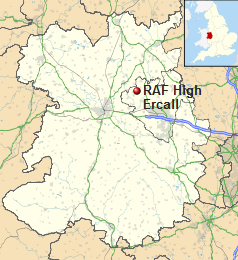
Location map for RAF High Ercall. Map shows modern road layout and Local Government boundaries.
[Map template : Wikipedia] |
The first three weeks after the Squadron’s arrival here to re-equip with Beaufighter VI's the weather was almost consistently bad with the result that the Squadron, instead of carrying out between 140–215 hours of night flying as was the practice on operations at Coltishall, only accomplished a total of 55 hours of night flying, all of which was non-operational. All ranks look forward to the day when the Squadron is operational again.[38]
Someone, somewhere, was already thinking of re-deploying the squadron into a more hostile situation. On 29 March the squadron undertook "Defence Exercises" to test the defence of the aerodrome. The imminent threat of a German invasion of Britain having faded by this date, something else was going on – but there is no known record of anybody rumbling what it was.
[39]
On the same day the first Mk.VI Beaufighters arrived. The last reached the squadron on 24 April along with a Miles Master collected from 61 OTU at RAF Rednal.
[40] As with the Miles Magisters, this single-engine aircraft seems to have been used only as an air taxi. There is no indication that it was either flown or shipped to Africa when that move eventually came about.
It was during the squadron’s stay at RAF High Ercall that Freddie Lammer, Senior Radio Observer, acquired his nickname of "The Masterly Manipulator". Freddie was in charge of a piece of kit best described as a Flight Simulator for AI operators. This equipment honed the skills of the Radio Observers (soon to be re-designated "Navigators Radio" or N/R's), especially in terms of interpreting the way in which the display on a Mk.IV AI set apparently flipped if the Beaufighter banked hard whilst giving chase. Standing the fighter aircraft on one wingtip resulted in the azimuth and elevation displays of the two-CRT system exchanging places. Allowance had to be made for this by the second crew member and navigational instructions amended accordingly, otherwise the target would be lost. The information presented to the radar operator was clear enough when the Beaufighter was in straight and level flight, but things were very different if the aircraft was being thrown around the sky in close-quarters combat.
[41]
Freddie, who manipulated the instructor’s controls of this kit in masterly fashion, excelled as a tutor. His apparently innate skill as a teacher was to remain with him through and beyond his time in the RAF.
Operational night flying resumed using a Mk.VI aircraft (X7931) on the night of 7–8 April 1942, the sortie being a "Precautionary night patrol". No enemy aircraft obliged by presenting themselves as targets. Possibly a good thing; the Form 541 records "weapon bent" – code for a defective radar set.
[42]
On the night of 25-26 April the squadron’s luck changed. 89626 Flying Officer Hugh Graham Stanhope Wyrill (Pilot) and 973558 Sergeant John Willins (Navigator Radio mis-described in the ORB as Radio Observer) flying X7933 were on a non-operational night patrol when "trade" appeared unexpectedly. Control was passed to Comberton (a GCI station located near the village of Wick, Worcestershire) and the Beau was vectored towards a lone hostile aircraft in the vicinity of Hereford. The intruder, a Junkers Ju.88 of
Kampfgeschwader 3, was duly shot down, one open parachute being observed before the enemy aircraft hit the ground and exploded.
[43] It crashed just over the Welsh border, on Gwaunceste Hill near Glascwm. Two of the four crew (Oberfeldwebel Walter Kreinenbrock, the navigator, and Obergefreiter Paul Kochon, the wireless operator) survived to become PoWs; the pilot Oberleutnant Guenter Brixius and the gunner, Feldwebel Adolf Leibig, were killed.
[44] [45]
The ORB records that...
"This success brought much encouragement to all members of the Squadron, as well as to the Station, and congratulatory messages, both by telephone and telegram, came from Group, Sector and various sections of the Station."
Maybe the aircrew had been given an uplift by the receipt, on the 23rd, of 5,000 cigarettes donated by the Royal Over-Seas League?
[46] Be that is it may, the fillip to morale generated by Wyrill and Willins’ success appears to have enabled the Squadron to shrug off an adverse incident that soon followed... the forced landing three nights later of a nearly-new Beau Mk.VI (X7934) following a Hercules engine failure. No crash this time though; the better single-engine handling characteristics of the Mk.VI aircraft may well have played their part. A successful return to base on one engine, in the dark, was achieved by Pilot Officer Woolley. The solemn days of the Beau II and its Merlin engines seemed to be over.
[47] In fact, further fatalities in incidents caused by engine failure were to come, but Wooley had proved that safe landing of a Mk.VI on one engine could be achieved.
Effective 28 April, in consequence of new Standing Operational Instructions issued by No.9 Group, two aircraft were placed on 30 minute availability throughout the daytime in order to deal with enemy aircraft operating in conditions unsuitable for day fighters.
[48] This kept everybody on their toes during what proved to be a well-forecast spell of bad weather, but the air war over England had gone quiet. Night after night the ORB recorded "No operational night flying. No enemy aircraft in the Sector." The comment was often suffixed by "...and weather u/s".
An incident on 19 May exposed a design flaw in the Beaufighter Mk.VI's undercarriage. X7931 "bumped" on take-off, just at the point when the hydraulic rams were down but the selector lever was in the 'up' position. This caused a lock-up of the whole mechanism, preventing the undercarriage from being either raised or lowered. Neither aircrew suffered injury in the inevitable crash-landing, which was effected on grass beside the main runway.
[49]
On 6 June 1942 the Squadron moved from RAF High Ercall to RAF Honiley, changing places with No.257 Squadron, No.3010 Echelon and No.1456 Flight. The move was completed in a single day. Bruce, of course, went too.
[50]
The squadron at Honiley
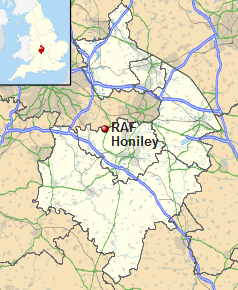
Location map for RAF Honiley. |
|
The ORB entry for 11 June records that 33168 Wing Commander DPDG Kelly, 45393 Flight Lieutenant PC Wright and 1150232 Corporal (since promoted F/Sgt) J Cunningham were Mentioned in Despatches in the King’s Birthday Honours List. [51] [52] Regrettably no copies of the Mentions themselves have been traced. The simultaneous appearance of Kelly’s and Wright’s names hints at a connection with the Merlin XX engine issue at Coltishall, but this has not been substantiated.
The dearth of targets experienced at High Ercall continued, the ORB repeatedly recording "No enemy aircraft in the vicinity". An encounter with what was probably a Ju.88 on the night of 24/25 June was unproductive. [53]
On 12 July, 656980 Sergeant Alan Richard Parker (Pilot) and 1254048 Sergeant Alexander Guthrie were killed on a non-operational flight, their Beaufighter X7945 crashing near Hatton Mental Hospital. Documented radio traffic suggests that the aircraft suffered an engine problem. [54] |
Officers and Aircrew, mid-July 1942 at RAF Honiley
| |
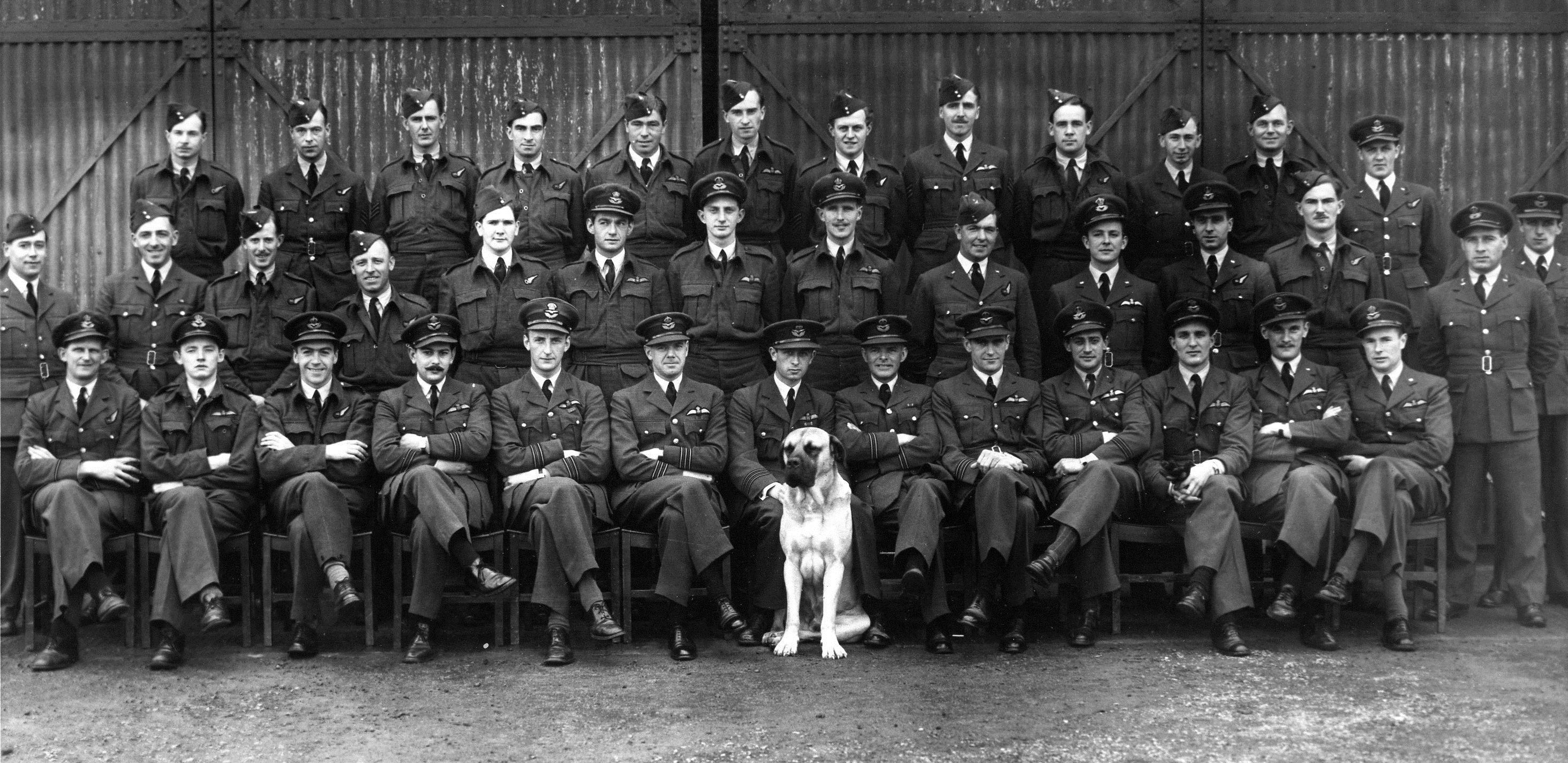 |
|
Later the same month, on the 27th, X8021 crashed at Preston Field, Henley-in-Arden, at 15:50. 1162810 Sergeant Douglas Charles Penwarden was killed, the pilot 108608 Pilot Officer Anthony Sheldon Kench and 1078136 AC1 Lewis, B.L. were both burned but survived. P/O Kench made commendable but unsuccessful efforts to extricate his Observer from the wreckage, himself eventually being dragged clear by a civilian witness, a Mr. Jenkins of 76 Bristol Road, Edgbaston.
[55] The cause of the incident was a forced landing consequential upon failure of the port engine.
The AOC of No.9 Group, after investigating this incident, subsequently wrote to Wing Commander Kelly in the following terms:
You are requested to commend P/O A.S. Kench for his gallant conduct after the accident on the 27th July, 1942. It is clear that he returned several times to the burning aircraft in an attempt to rescue his Radio Observer, Sgt. D.C. Penwarden, regardless of his own safety and at risk of exploding ammunition. Such conduct is in accordance with the best tradition of the Service. The investigation has also made it clear that he did all that was possible from the moment his engine failed and that the judgement which he showed resulted in two out of three lives being saved.[56]
At 02:07 on the night of 27–28 July, Flight Sgt. Kendall and Pilot Officer Hill flying X7931 were vectored onto a He.111 by GCI Comberton as a diversion from an exercise. In the ensuing chase, each aircraft fired and scored hits, but neither conclusively destroyed the other. 255’s Beau broke off the engagement having expended all ammunition. Another 255 Beau airborne at the time, crewed by Pilot Officer Winton and Flight Sergeant Wall, reported seeing an aircraft dropping in flames to the north of Birmingham, but this has never been conclusively proved to have been the He.111 attacked by Kendall and Hill. Therefore their claim remains listed as 'damaged'.
[57]
On the night of the 30–31 July, Wyrill and Willins (the crew who had shot down the Ju.88 over the Welsh border whilst the Squadron was at High Ercall) had an encounter with an He.111. The result was inconclusive, but the Beaufighter was found to have sustained some thirty impacts from pieces of the Heinkel that had been shot away. Surviving records of KG3, the likely German unit involved, are patchy. This makes it impossible to determine with any certainty whether such damaged Luftwaffe bombers ever actually made it home or whether they should be added to No.255 Squadron’s list of 'kills'.
[58]
A note at the end of the ORB monthly summary for July 1942 merits quoting in full:
This month the Squadron has, for the first time since leaving No.12 Group, had the opportunity of meeting hostile aircraft in any quantity. The results, from the Squadron’s point of view, have, however, been disappointing and have naturally caused a certain amount of discussion amongst the pilots in the Squadron and this has led to the following conclusions.
(i) When hostile aircraft have attacked the Coventry/Birmingham area the Squadron, by virtue of its position being almost on the 12 Group boundary, has had little, or no, opportunity for using a GCI Station capable of affecting interception of raids from the east or South East.
(ii) The inability of the Squadron to go out and meet the raids some distance from the target owing to infringing another Group boundary has necessitated pilots attempting difficult interceptions on the fringe of the target, or actually in the target area itself, at a time when hostile aircraft are circling prior to dropping their bombs. Owing to this there is also the possibility of pilots going over gun defended areas in the excitement of the chase.
(iii) On moonlit nights the black camouflage of the Beaufighter aircraft shows up very clearly at considerable distance and has enabled several hostile aircraft to take evasive action before our pilots managed to come within firing range.
(iv) The large concentration of friendly aircraft in such a small area led to mutual AI interference, and constant AI contacts on our own Beaufighter aircraft.
(v) Owing to the difficulty experienced by the ROC in plotting the E/A inland the first warning has on occasions been received just prior to the E/A bombing the target.
It is hoped that, if authority can be obtained to operate in another Group areas and to use their GCI stations, the Squadron will meet with greater success in the future.
(Document signed D.P. Kelly,Wing Commander, Commanding No.255 Squadron RAF)
This must have had some effect; the following month’s records show 255’s aircraft ranging as far as Watford and Ipswich, both well into No.11 Group’s territory.
On 6 August 1942 the Squadron received a visit from representatives of the Press in the Midlands, overseen by a Colonel P.L. Vining of the Ministry of Information. Not all the newspapers chose to report their visit and those that did wrote pieces ranging from the jingoistic to the scathingly critical.
[59] AI radar was still secret, so attention seems to have been concentrated on the dark goggles worn by aircrew in the Ops Room (to preserve night vision), nicknames and mascots. Bruce, of course, managed to steal the show and his image takes pride of place on Page 3 of the Birmingham Post’s AM edition of Wednesday 12 August 1942.
September opened on a sour note; 754519 Warrant Officer Stanley Joseph Johnson and 1394363 Sergeant Roy Fairmead Ellis being killed in the unexplained crash of X7943 on the night of 01-02 September. Their aircraft came down near Snitterfield, Warwickshire, during a thunderstorm. Then, just days later, pilot 655801 Sergeant John William Perry was killed whilst practising single-engine flying. His navigator, Pilot Officer W. Palfreyman somehow jumped from the aircraft (X7957) as it crashed and escaped with minor injuries.
Occasionally, despite best efforts to maintain standards as regards use of English, the ORB contains a howler. It records that, on 07 September, the Squadron doctor, 104983 Flying Officer Terence Nigel Norman Brennan M.B., B.Ch., attended a "Pathological Course" at RAF Halton. Maybe, just maybe, that should have said "Pathology Course"?
On 19 September the Squadron ceased to maintain any Operational State, day or night and by the 22nd of the month 18 new Beaufighter Mk.VI's had arrived. One of the new aircraft (X8433) was belly-landed on 27 October, without injury to the crew. The rest were the subject of cleaning, stripping, rubbing down and re-camouflaging.
The first part of November saw the whole squadron, from the CO down to the newest AC2, toughening up for service in the front line... somewhere. But the majority knew not where. Interspersed with dreaded innoculations from Doc Brennan and joys such as Embarkation Leave, almost all personnel went on an Army Battle Course held near Warwick – there experiencing being on the receiving end of live firing by army sharpshooters and returning fire with blanks whilst hiding in slit trenches. The exercise ended with their positions being driven over – literally – by Bren Gun Carriers. The ORB records that the "Baptême du Feu" brought forth a change of outlook, a realisation that as well as their specialist job each might soon have to demonstrate prowess with a lethal weapon.
[60]
On 13 November, at 12:45, the Beaufighters of No.255 Squadron took off from RAF Honiley for the last time, knowing only that their next stop was RAF Portreath in Cornwall. The Union Jack flew from the Control Tower and a "small pyrotechnic display" sent them on their way.
 |
Click on the music icon and sing along with Vera Lynn: “Wish me luck as you wave me goodbye...” |
Citations and Footnotes
Click on the ^ symbol to return to the text you were reading.
|
1. ^ |
For details of what is to be found in an Operations Record Book, see http://www.nationalarchives.gov.uk/records/raf-operations-record-books.htm |
|
2. ^ |
TNA : AIR27/1518. |
|
3. ^ |
TNA : AIR28/427 (Overview, various dates 1940–1941). Original document – requires TNA Readers Ticket to view. |
|
4. ^ |
TNA : AIR27/1518 folio 6. Available online from TNA website, part of .pdf file AIR27/1518/1. |
|
5. ^ |
TNA : AIR27/1518 folio 7. Available online from TNA website, part of .pdf file AIR27/1518/2. |
|
6. ^ |
Duxford Radio Society / Equipment History / Pip-squeak |
|
7. ^ |
TNA : AIR27/1518 folio 8. Available online from TNA website, part of .pdf file AIR27/1518/3. Also TNA : AIR81/4975. This Casrep file has been declassified but not digitised. Original document – requires TNA Readers Ticket to view. |
|
8. ^ |
Details of these events appear in our Scoresheet chapter – link in the navigation panel below. |
|
9. ^ |
TNA : AIR27/1518 folio 11A side 2. Available online from TNA website, part of .pdf file AIR27/1518/5. |
|
10. ^ |
TNA : AIR27/1518 folio 19 side 2. Available online from TNA website, part of .pdf file AIR27/1518/9. |
|
11. ^ |
TNA : AIR27/1518 folio 25 side 1. Available online from TNA website, part of .pdf file AIR27/1518/11. |
|
12. ^ |
TNA : AIR27/1518 folio 25 side 2. Available online from TNA website, part of .pdf file AIR27/1518/11 Supra. The archive of Forms 78 at the RAF Museum Library, Hendon, suggests this was L1301. |
|
13. ^ |
TNA : AIR27/1518 folio 29 side 1. Available online from TNA website, part of .pdf file AIR27/1518/13. |
|
14. ^ |
The ORB suggests L8660 (TNA : AIR27/1518 folio 30 side 1. Available online from TNA website, part of .pdf file AIR27/1518/13 Supra) but the Form 78 records held at the RAF Museum Library, Hendon, show the aircraft delivered to have been L8680. |
|
15. ^ |
TNA : AIR50/98/4. Available online from TNA website as an individual document. |
|
16. ^ |
TNA : AIR27/1518 folio 29 side 2. Available online from TNA website, part of .pdf file AIR27/1518/13 Supra. The Casrep file has been declassified but not digitised, available as AIR81/7570. Original document – requires TNA Readers Ticket to view. The original perpetuates the confusion over the spelling of Fitzsimons' surname. |
|
17. ^ |
TNA : AIR27/1518 folio 35 side 1. Available online from TNA website, part of .pdf file AIR27/1518/15. |
|
18. ^ |
TNA : AVIA10/262, tabulated appendix paginated "1B" (the last three pages of the file). In respect of both Hercules and Merlin engines, allowance was made in the original research for incremental performance improvements since the original engine design. Original document – requires TNA Readers Ticket to view. |
|
19. ^ |
Bingham, V. (1994). Bristol Beaufighter, Shrewsbury : Airlife Publishing. p.25. ISBN 1-85310-122-2. |
|
20. ^ |
Form 1180 relating to this incident, filed in the library of the RAF Museum, Hendon. |
|
21. ^ |
TNA : AIR27/1518 folio 36 side 2. Available online from TNA website, part of .pdf file AIR27/1518/15 Supra. |
|
22. ^ |
National Grid Reference SK106969. Note that "Near Bleaklow Stones" (with a capital N) is a place in its own right, not a synonym for "in the vicinity of Bleaklow Stones". |
|
23. ^ |
TNA : AIR27/1518 folio 40 side 2. Available online from TNA website, part of .pdf file AIR27/1518/17. |
|
24. ^ |
Pers. Corr. with "High Peak Bob", a regular local trekker. See also Collier, R. and Wilkinson, R. (1990), Dark Peak Aircraft Wrecks 1 Revised Wharncliffe Publishing, ISBN 0-85052-457-1, photograph at p.30. |
|
25. ^ |
Wynne-Willson, M.F. (2003). Before I Forget! Bloomington : 1stBooks, p.161. |
|
26. ^ |
TNA : DSIR23/14491 (Technical Note number Aero 1617). Original document – requires TNA Readers Ticket to view. |
|
27. ^ |
Volume 1 Section 2 Paragraph 21 of Air Publication 1721B, archived as TNA : AIR10/2668. Original document – requires TNA Readers Ticket to view. |
|
28. ^ |
Wynne-Willson, M.F. (2003). Supra, p.163. |
|
29. ^ |
Kelly family archive. |
|
30. ^ |
TNA : AIR27/1518 folio 58 side 2. Available online from TNA website, part of .pdf file AIR27/1518/25. |
|
31. ^ |
TNA : AIR50/98/5 and AIR50/98/6. Both available online from TNA website, as individual documents. |
|
32. ^ |
TNA : AIR27/1518 folio 58 side 1. Available online from TNA website, part of .pdf file AIR27/1518/25 Supra. |
|
33. ^ |
TNA : AIR27/1518 folio 64 side 1. Available online from TNA website, part of .pdf file AIR27/1518/27. |
|
34. ^ |
Forms 540, 541 at TNA and Forms 1180 at the RAF Museum, Hendon. |
|
35. ^ |
Goulding, J. and Jones, R. (1970–1971). Camouflage & Markings. London : Ducimus Books. In magazine format, Edition No.9 "Bristol Beaufighter", pp.196, 210. The same publication also exists in book format, available at the British Library. |
|
36. ^ |
Form 1180 relating to this incident, filed in the library of the RAF Museum, Hendon. |
|
37. ^ |
TNA : AIR27/1518 folio 68 side 1. Available online from TNA website, part of .pdf file AIR27/1518/29. |
|
38. ^ |
TNA : AIR27/1518 folio 69 side 2. Available online from TNA website, part of .pdf file AIR27/1518/29 Supra. |
|
39. ^ |
TNA : AIR27/1518 folio 69 side 1. Available online from TNA website, part of .pdf file AIR27/1518/29 Supra. |
|
40. ^ |
TNA : AIR27/1518 folio 73 side 1. Available online from TNA website, part of .pdf file AIR27/1518/31. |
|
41. ^ |
Based on notes in the late Freddie Lammer’s unpublished personal diaries, abstracted here with the kind consent of his son. |
|
42. ^ |
TNA : AIR27/1518 folio 72 side 1 and folio 76 side 1. Available online from TNA website, part of .pdf file AIR27/1518/31 Supra and AIR27/1518/32 respectively. |
|
43. ^ |
TNA : AIR50/98/35 and AIR50/98/41. Both available online from TNA website as individual documents. |
|
44. ^ |
Website of The Aircrew Remembrance Society, which includes an extensive report of this incident. |
|
45. ^ |
Seller’s Notes relating to an auction of aircraft parts recovered from the crash site, August 2013, eBay item number: 2811498623. |
|
46. ^ |
TNA : AIR27/1518 folio 73 side 1. Available online from TNA website, part of .pdf file AIR27/1518/31 Supra. |
|
47. ^ |
TNA : AIR27/1518 folio 73 side 2. Available online from TNA website, part of .pdf file AIR27/1518/31 Supra. |
|
48. ^ |
TNA : AIR27/1518 folio 74 side 1. Available online from TNA website, part of .pdf file AIR27/1518/31 Supra. |
|
49. ^ |
TNA : AIR27/1518 folio 79 side 1. Available online from TNA website, part of .pdf file AIR27/1518/33. |
|
50. ^ |
TNA : AIR27/1518 folio 84 side 1. Available online from TNA website, part of .pdf file AIR27/1518/35. |
|
51. ^ |
Idem. |
|
52. ^ |
London Gazette Issue 35586 pages 2517 (Kelly), 2521 (Wright) and 2527 (Cunningham). |
|
53. ^ |
TNA : AIR27/1518 folio 85 side 1 and folio 87 side 2. Both available online from TNA website, part of .pdf files AIR27/1518/35 Supra and AIR27/1518/36 respectively. |
|
54. ^ |
TNA : AIR27/1518 folio 90 side 2. Available online from TNA website, part of .pdf file AIR27/1518/37. |
|
55. ^ |
TNA : AIR27/1518 folio 92, commencing at side 1. Available online from TNA website, part of .pdf file AIR27/1518/37 Supra. |
|
56. ^ |
TNA : AIR27/1518 folio 101 side 1. Available online from TNA website, part of .pdf file AIR27/1518/39. |
|
57. ^ |
TNA : AIR27/1518 folio 92 side 2 and folio 98 side 1. Both available online from TNA website, part of .pdf files AIR27/1518/37 Supra and AIR27/1518/38 respectively. |
|
58. ^ |
TNA : AIR27/1518 folio 94 side 1 and folio 98 side 2. Both available online from TNA website, part of .pdf files AIR27/1518/37 Supra and AIR27/1518/38 Supra respectively. |
|
59. ^ |
Scrapbook in the Kelly Family Archive, also the Central Library of the City of Birmingham and The British Library newspaper collection. |
|
60. ^ |
TNA : AIR27/1518 folio 110, side 1. Available online from TNA website, part of .pdf file AIR27/1518/43. |
Copyright © 2014–2025. All rights reserved except where otherwise stated.











